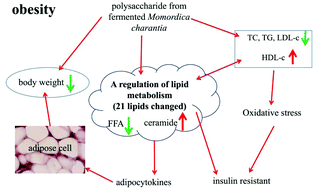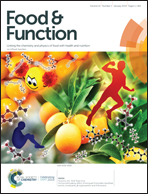Polysaccharides from fermented Momordica charantia ameliorate obesity in high-fat induced obese rats†
Abstract
Momordica charantia (M. charantia) has been widely used to treat obesity due to its bioactive ingredients. This research aimed to investigate the anti-obesity effect of polysaccharides (FP) from fermented M. charantia with Lactobacillus plantarum NCU116 on high-fat induced obese rats. We found that FP could effectively lower the body weight gain, Lee's index, insulin resistance and cell sizes of epididymal adipose tissues in obese rats compared with polysaccharides from non-fermented M. charantia (NFP). FP treatments decreased the total cholesterol, triacylglycerols, and low-density lipoprotein cholesterol, leptin, whereas they elevated the high-density lipoprotein cholesterol, adiponectin, significantly in the serum of obese rats. Furthermore, administrations of FP notably improved oxidative balance in obese rats. Lipidomics results indicated that 24 potential biomarkers have been identified in serum. Additionally, 21 lipids were considerably altered by FP and NFP intakes, such as fatty acyls, glycerolipids, sphingolipids, sterol lipids and glycerophospholipids. The anti-obesity properties of FP were revealed via relieving insulin resistance and fat accumulation of obese rats, which was associated with the regulation of lipid metabolism. Overall, FP exerted more favourable impacts on the anti-obesity effect than NFP, which may be attributed to fermentation.



 Please wait while we load your content...
Please wait while we load your content...